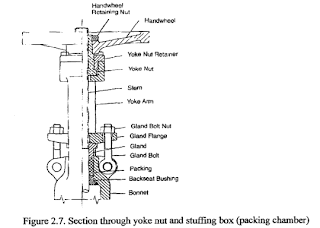- inside screw rising stem (lSR)
- non-rising stem (NRS), and
- outside screw and yoke (OS&Y).
1. Inside Screw Rising Stem (ISR)
- The inside screw rising stem (ISRS) is shown in Figure 2.2. The right-hand thread on the stem mates with an internal thread in the bonnet so that by turning the valve hand wheel clockwise the stem and gate are translated downward, closing the valve.
- The height of the stem outside the valve indicates whether the valve is open or closed. The ISRS usually used only on bronze valves.
2. Non-Rising Stem (NRS)
- A non-rising stem (NRS) is shown in Figure 2.6. This design is used where insufficient space above the valve limits stem movement upward. In this case a left-hand thread pn the stem mates with an internal thread in the gate. An integral stem collar held in the bonnet keeps the stem from moving up or down but permits it to turn. A left-hand thread is used so that turning the handwheel clockwise closes the valve. Because the stem does not move upward, it can not be used to determine whether the valve is open or closed. The NRS usually is found only on bronze and cast iron valves.
- The outside-screwand-yoke (OS&Y) design shown in Figure 2.7 prevents thread wetting because the threaded portion of the stem is outside the valve. The stem passes through a yoke, which is formed by two arms that extend up from the bonnet and joint to form a housing for a yoke nut (also called a stem nut, yoke bushing, or stem bushing). Unlike the other stem designs, the hand wheel is attached to the yoke nut rather than to the stem. The yoke nut is free to turn but is held in place at the top of the yoke by a yoke-nut retainer, which also acts as a bushing for the nut. The yoke nut has a left-hand internal thread that mates with the thread on the stem. The stem thread is left-handed so that turning the hand wheel clockwise moves the stem downward, closing the valve. In this design the stem does not turn and may be pinned to the gate; The position of the gate within the valve is easily determined from the position of the top of the stem. The OS&Y design is standard for all sizes of cast iron and steel gate valves.
In all three stem designs, external leakage along the stem is prevented by the use of deformable non-metallic packing. The packing is located in the bonnet in a circular cavity commonly known as the stuffin box or packing chamber. In valves using ISRS and NRS stem designs, the packing is held in place by a tubular gland backed by a hollow packing nut that threads onto the top of the bonnet. In valves using the OS&Y stem design, the packing arrangement is more complicated. The packing is held in place by a gland, which is backed by a gland flange. The gland flange is restrained by a pair of gland bolts and nuts, which are, in turn, fastened to the bonnet using eyes and pins or some comparable arrangement.



